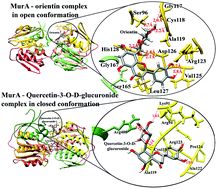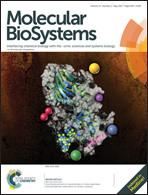Inhibition of the MurA enzyme in Fusobacterium nucleatum by potential inhibitors identified through computational and in vitro approaches†
Abstract
Fusobacterium nucleatum plays a key role in several diseases such as periodontitis, gingivitis, appendicitis, and inflammatory bowel disease (IBD). The development of antibiotic resistance by this bacterium demands novel therapeutic intervention. Our recent study has reported UDP-N-acetylglucosamine 1-carboxyvinyltransferase (MurA) as one of the potential target proteins in F. nucleatum. In this study, we proposed two novel MurA inhibitors through in silico screening and evaluated their mode of inhibition by in vitro experiments. It was found that MurA structural arrangement (inside-out α/β barrel) was stabilized by L/FXXXG(A) motif-based interactions. The protein was maintained in an open or substrate-free conformation due to repulsive forces between two parallelly arranged positively charged residues of domain I and II. In this conformation, we identified six best compounds that held key interactions with the substrate-binding pocket via a structure-based virtual screening of natural and chemical compound libraries. However, among these, only orientin and quercetin-3-O-D-glucuronide (Q3G) showed better interaction capability through consistent H-bond occupancy and lowest binding free energy during molecular dynamic simulations. In vitro inhibition studies evidenced the mixed and uncompetitive mode of inhibition by orientin and Q3G, respectively, with purified MurA protein. This explains the binding of orientin in both open and closed (substrate-bound) conformations of MurA, and Q3G binding in only closed conformation. Therefore, the Q3G binding mode was predicted on a MurA–substrate complex, which highlighted its constant H-bond with Cys118, a phosphoenolpyruvate (PEP) interacting residue. This suggests that Q3G may interrupt the PEP binding, thereby inhibiting the MurA activity. Thus, the current study discusses the structure of MurA and demonstrates the inhibitory action of two novel compounds.



 Please wait while we load your content...
Please wait while we load your content...